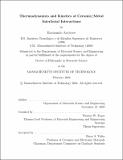Thermodynamics and kinetics of ceramic/metal interfacial interactions
Author(s)
Arróyave, Raymundo, 1975-
DownloadFull printable version (5.417Mb)
Other Contributors
Massachusetts Institute of Technology. Dept. of Materials Science and Engineering.
Advisor
Thomas W. Eagar.
Terms of use
Metadata
Show full item recordAbstract
Ceramic/metal interfaces occur in a great number of important applications, such as ceramic/metal composites, microelectronics packaging, ceramic/metal seals, and so forth. Understanding the formation and evolution of such interfaces is therefore essential for the better design and optimization of these technologies. In this thesis, a methodology for the study of the thermochemical interactions at ceramic/metal interfaces, during both their formation and evolution, is proposed. Because of the importance of zirconia-based ceramics in increasingly important applications such as structural composites, thermal barrier coatings and Solid Oxide Fuel Cells, it was decided to illustrate the concepts developed in this thesis through the study of the interactions between zirconias and active metals. Semi-empirical thermodynamic models of all the phases likely to take part in the ceramic/metal interfacial interactions studied were developed. Phase diagram data and thermochemical information were critically assessed and use to adjust the thermodynamic parameters that allowed the description of the Ag-Cu-Ti, Cu-Ti-Zr, Ti-Zr-O, Cu-Ti-O and Cu-Zr-O systems. The thermodynamic models were used to predict the diffusion paths across zirconia/active metal interfaces through metastable phase diagrams calculations. Additionally, equilibrium calculations of activity diagrams were used to understand the complex interfacial reactions occurring during the active metal brazing of zirconia-based ceramics. (cont.) By using simple one-dimensional interdiffusion simulations, it was demonstrated that the base metal in ceramic/metal joints plays an essential role in determine the thermochemical interactions at the ceramic/metal interface during ceramic/metal joining operations. In general it was found that, using all these techniques,it was possible to explain diffusion paths and reaction sequences observed in a great number of zirconia/active-metal systems, both in the solid and in the liquid states. In many cases, the morphology of the reaction layers formed at ceramic/metal interfaces determine their final properties. To address this problem, empirical thermodynamic models of the likely reaction products at zirconia/metal interfaces were coupled to kinetic models using the diffuse-interface formalism to successfully describe the formation and evolution of complex ceramic/metal interfacial structures.
Description
Thesis (Ph. D.)--Massachusetts Institute of Technology, Dept. of Materials Science and Engineering, 2004. Includes bibliographical references (p. 237-248). This electronic version was submitted by the student author. The certified thesis is available in the Institute Archives and Special Collections.
Date issued
2004Department
Massachusetts Institute of Technology. Department of Materials Science and EngineeringPublisher
Massachusetts Institute of Technology
Keywords
Materials Science and Engineering.